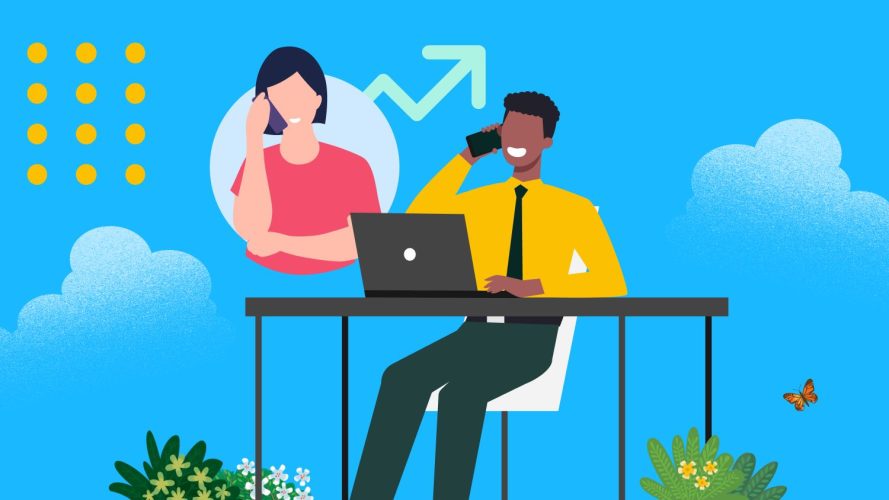3 Ways Generative AI Will Help Marketers Connect With Customers
3 min read


Most of the advice I’ve heard about upselling is about making the sale. That’s a big mistake. Instead of being hyper-focused on numbers, the best sellers think about what value and solutions they can deliver to their customers. When that happens, the opportunity to upsell flows naturally.
Below are my tried-and-true upselling strategies to help you create deeper customer relationships — and higher profits.
Learn how the AI insights and real-time data of Sales Cloud can help you identify upsell opportunities by surfacing relevant customer signals.



Upselling is when a seller encourages a customer to buy a more expensive version of a product or service than they originally intended.
Successful upselling follows the same guiding principles as first-time sales: Yes, it helps you hit your sales quotas, but it should ultimately be a way to deliver value and help your customer achieve their goals. This builds trust, which lays the foundation for a long-term relationship and customer loyalty.
Upselling involves upgrading a customer to a more expensive product or service, while cross-selling is about selling complementary add-ons to something the customer has already purchased.
Let’s say a customer hires me to do a one-time sales training session. To upsell, I might offer a premium package at a discount that includes refresher classes once every quarter. Instead of selling just one training session, I have the potential to sell four.
Cross-selling looks different. In the same example, I might ask the customer if they’d like to order several of my books at a discounted price. This isn’t an upgrade to the sales training; it’s a related purchase.
In two words: more revenue. Upselling delivers a higher-value deal than an entry-level sale, helping reps hit quota and sales teams meet targets quickly. It also builds customer loyalty by solving a pressing customer problem. When you can meet your customer’s needs, they’re more likely to stick with you.
The greatest return on investment for your team is always going to come from your existing customers. According to Harvard Business Review, it costs five times more to win a new customer than to keep current ones. This is especially true during economic downturns – when business slows and new leads are harder to come by, the cost to acquire new customers increases.
An upsell can happen at almost any stage of the sales process – if you read the cues. But those cues often don’t surface on their own. Combine open-ended questioning with active listening and careful research to get the signals you need. Here are some tips to get started:
Every conversation with a prospect or customer should begin with an open-ended question about how things are going. Think of it as information harvesting — an opportunity for your prospect to open up about their needs, state of mind, current situation, and general interests. Showing basic concern for their well-being builds trust and engages them in a conversation that can yield new information an upsell might address.
This happens all the time in my conversations with clients. When I ask: “How have you been doing?” I often hear things like, “It’s been really busy, and I haven’t had much time to spend at home,” or “It’s been a little slow — which is nice, but would love to really dig in with some new customers.” This information helps me scope more tailored training they might not have considered. I can suggest this new training as sales conversations progress.
The flip side of open-ended questioning is active listening. After asking your open-ended question, listen for need or problem signals, like “I’m struggling with…” or “I don’t have enough of …” Ask probing questions to go deeper into the issues they bring up. Think about how these align with your company’s solutions.
When I hear client concerns about too much to do and no time to do it, I’ll often ask what types of tasks end up on the back burner. Then I think about training I can customize to target efficiency in their business. This training costs a bit more, but it’s effective for the client in the long run.
Take time, at least weekly, to research your prospects and customers. This surfaces needs you can address with upsells (and cross-sells). Start by tracking target companies on social media, especially LinkedIn. Set up Google alerts for their names. Keep an eye on their public presence, like storefronts and advertising, for clues as to what their needs might be. Read up on the latest in your customers’ industries to see what’s happening on a macro level.
AI offers a way to dive into customer intelligence quickly. Sales Cloud, powered by Einstein, can do a lot of this research for you by surfacing recent articles, collecting industry and business intel from relevant sources, and pulling it all into your CRM. With the help of automation, it updates deal records with this information automatically so sellers can spend more time selling.
You’ve got the signals. Now how do you go for the upsell? The key is a combination of preparation and timing: Stay up-to-date on product or service knowledge and customer insights. Then, tailor your offer to specific needs as soon as they’re articulated. The key is framing every upsell as a value-first solution — that’s how you build loyalty. Here are six best practices:
Upselling is not all about outreach. If you’ve landed a successful first sale, customers might have questions about your product or service. Prospects might also come directly to you when they’re ready to buy. Both of these are perfect opportunities for upselling, but they’re only possible if it’s easy to contact you.
Make sure a “contact us” phone number and email are prominent on your website. Activate a chatbot that can answer basic questions and triage customer support. And don’t let those contacts go cold – follow up on any leads within 24 hours.
Chances are, your product or service portfolio is constantly changing. New features, new models, new subscription tiers. Before you ever reach out to a customer, get to know the latest so you can be prepared to explain the benefits if upsell signals arise. Watch demos, sign up for free trials, and talk with the product or service development team regularly to make sure you have the latest information.
Part of the secret sauce to upselling is timing. When the customer tells you about a need or problem, introduce your product or service as a solution. If you stay on top of customer research and your product’s newest features, it will be easy to connect their needs to your offerings.
Your goal in upselling is to create the most impactful solution possible. You may be tempted to go for an upsell simply because it will help you hit quota, but that may wreck the relationship with your customer. Instead of asking, “How can I get more money out of this deal?” ask “Knowing this customer and my product, how can I help them hit their goals?”
The biggest reason a customer says “no” to an upsell is risk. The cost is too high without a guaranteed return on investment, or they worry about seeing quick time to value. My response is to take away the risk, often by offering a free trial or heavy discount. When there’s no risk, there’s no reason to say “no.” And once they try your product or service and see the value, it will be easier to seal the deal.
I tell my clients that upsells should not increase the total price to the customer by more than 25%. In B2B, this is just small enough of an increase that budgets typically don’t have to be reworked and re-approved. In retail, it’s a matter of perception: 25% more cost for a marked increase in features or quality is a relatively easy sell. (This depends on the business and industry, of course, but it’s held true in my experience.)

3 min read

6 min read
Here’s a recent example of upselling ripped straight from personal experience:
Years ago, I went shopping for a basic pair of new activewear shoes. The sales rep, Elaine, didn’t ask the usual “Can I help you with anything?” She tossed out a conversation starter: “You look active. What sort of exercise do you enjoy?”
I told her I love to run, but suffered from plantar fasciitis. After a painful course of cortisol injections in my ankles, the doctors recommended shoes with special padding to protect my feet. Even so, I wasn’t sure it was worth the money – I just wanted a basic pair.
Elaine listened, then recommended a pair with arch support that was designed for people with my exact issue. I walked in planning to spend no more than about $100 — a reasonable amount for a basic pair of running shoes — but the $140 shoes she recommended were actually more comfortable and addressed my specific needs. It wasn’t hard to convince me to buy; in a few minutes, I was at the register, ringing up my new shoes and thanking Elaine for her recommendation. Upsell successful.
To win the upsell, know your customers and keep them in mind at every stage of the sale process. Understand potential issues, take time to do your research, listen actively to their needs, and jump on upsell opportunities when the moment is right. If you can do that, you’ll build long-term customer relationships, while earning welcomed revenue boosts.
Want to get the latest upselling techniques from sellers in the field? Share questions and get insights from Salesblazers across industries.




Get the latest articles in your inbox.